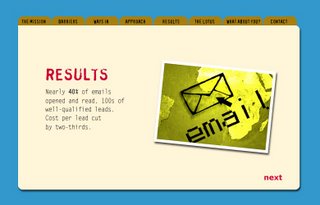From those wonderful folks
who brought you… YUPPIES!
Computers bring with them the notion that anything some sap with a pencil and paper can do, the computer can do faster, more accurately, and more completely. In marketing, especially direct marketing, they bring something more¾the notion that we can go beyond simple lists of names and addresses to completely identify our target market and link their lifestyles and desires to our products and services.
Database marketing is the general name for such an approach to marketing. A specific tool database marketers use to help them profile and find target markets is geodemographics. That polysyllabic mouthful is the marketing offshoot of GIS -- Geographic Information Systems -- which has long been used by resource companies and various levels of government to understand the nature of the territories they exploit or manage. For example, it’s important for a forest company to know the types of trees and volume of harvestable timber on a tree farm, and it’s important for a municipality to know where various above and below ground services are located.
Geography plus lifestyle.
When geography is linked to information, that’s GIS. When the information is about people and their lifestyles, that’s geodemographics. Dividing people into geographic groups based on lifestyles is called segmentation, or clustering, and is the very heart of geodemographics.
So, how do marketers use geodemographics? What kinds of information does it give them?
Imagine you’re looking at a map of Kelowna. One way of dividing up the city is by Enumeration Areas -- boundaries set by Census Canada, containing some 250 to 400 households. Basic census information about the households in those areas is readily available: average ages, male/female ratio, average incomes, number of children, and more. Stats Canada also conducts a survey of the spending habits of about 20,000 randomly selected households. This Famex survey data is also available to geodemographers, along with other lifestyle information garnered through privately conducted surveys. So you can look at a particular area of Kelowna, and know with some certainty that the people living there are more apt to drive Mazda pickups than BMWs.
Where Yuppies came from.
Geodemographers know that people tend to live in neighbourhoods with other people who are like them -- they tend to cluster. Remember the Young Urban Professionals -- the Yuppies? That was a name used to describe certain lifestyle characteristics in the 1970s. Whether or not it’s still in use, I don’t know. But Generation 5, which distributes MOSAIC segmentation data in Canada, and is a licensed sales agent of Stats Canada, uses such terms as The Moderates, The Spendthrifts, Inner City Elite and Blue Collar Survival to describe different segments of the Canadian Population.
Compusearch Canada Ltd. (which I believe is now part of Mapinfo) and Tetrad Computer Applications Ltd. are Canadian distributors of MapInfo, a software tool used for mapping various demographic and lifestyle databases, including MOSAIC. MapInfo uses different terms, such as Urban Affluent, but the result is basically the same -- to carve up the Canadian population into recognizable groups and subgroups based on lifestyle and other attributes.
This is where the fun really starts.
When you combine all of the lifestyle and demographic information with Canada’s wonderful postal code system, a process called geocoding, you begin to create data files that are of enormous interest and use to marketers because they are so narrowly focused.
Instead of 200 to 400 homes, you’re now looking at as few as 10 or 20. And you can now begin to make very intelligent decisions about which lifestyle segments are most likely to be interested in your RSP offerings, which are more likely to buy travel products, consumer electronics, and so on. Then you can reach these people easily, by mail, or through targeted messages in selected media.
You can also map and segment your own database to find out which groups your best customers or donors are in, and then use that information to go prospecting in similar neighbourhoods. Incidentally, segmentation data is not just available for households, it’s also available now for business and industry -- a major boon for business-to-business marketers.
Finally, by using other analytical techniques you can add transaction information -- recency, frequency and monetary value -- to create a powerful marketing tool that gives you a detailed look at your market, right down to the level of a single postal code. The uses of geodemographics seem almost endless, from selecting sites for new stores, to planning routes for deliveries, managing cellular phone cell sites, or planning householder drops for new pet food samples.
Use it or lose it.
But for all the benefits of geodemographics, it does not yet appear to be in widespread use in Canada. Kirby Allen, general manager for Toronto’s Generation 5 says a lot is done, but at a rudimentary level which does not come near to using the full power of it.
“It’s a very sophisticated tool which many marketers haven’t the time or expertise to use fully. That may not be a bad thing, because it avoids the danger of oversimplifying geodemographics. If you don’t do a proper job of targeting, it’s easy to run your costs up, get poor response rates, and then blame the method. There just aren’t many service providers yet with access to good data in combination with expertise in modeling that data.”
Another source of resistance to geodemographics may come from marketing companies and other suppliers, who might see revenues drop because sophisticated targeting can lead to smaller print runs and more selective media buying.
“There’s some complacency in the Canadian market,” Allen notes, “but there is increasing pressure to change from US service providers who do come up here and use geodemographics.”
David Garratt, an independent marketing consultant based in Vancouver who specializes in geodemographics, agrees that spreading the gospel can be difficult.
“But once people really understand what it can do, you can actually see their expressions change. First they get it. Then they want it.”
Strengths and weaknesses.
Garratt says the main strength of geodemographics is that it helps you organize your customer database by market area, or any other level of geography, right down to the street level -- even a single block.
“You can use it to find out who’s buying what, who’s driving your market. From there, you can use your marketing skills to generate more revenue.”
He says its main weakness is that you still don’t really know many details about the individuals in your target group.
“You have to make assumptions, based on statistical surveys, and sometimes you can assume wrong.”
He notes the example of a non-profit society which found the bulk of its donations came from a group defined as young urban. These are people to whom you would talk differently than to, say, seniors. And yet a further look into their database, this time using age as the search criterion, revealed that fully 38% of the seniors on their database lived in the young urban neighbourhoods. Not knowing that, not bothering to cross-check the data, could have led to them sending out messages that would turn off their loyal seniors.
Geodemographics goes Hollywood.
In an interview, actor, director, producer Warren Beatty bemoaned the fact that bean-counters now run Hollywood and make decisions about what movies to make based on demographics.
“It’s like driving a car by looking in the rear view mirror,” Beatty complained.
“There’s some truth in that,” says Garratt. “You definitely are looking at yesterday’s behaviour. But it’s also true that when you really know the past well, you have a edge in creating structure for the future. Geodemographics gives you a big edge.”
Expensive? Or well worth the cost?
Since geodemographics encompasses both software tools and data sets, you’re looking at quite a bit more cost than a piece of off-the-shelf software from Future Shop. MapInfo costs over $1,000 for the basic software, with a variety of other modules for viewing, mapping and manipulating data that can easily add thousands of dollars more to your cost. On top of those there are various data maps of Canada and other countries, plus geocoding information that can add more thousands dollars more to the cost.
Here are some websites with more information about geodemographics:
http://www.mapinfo.ca/
http://www.generation5.ca/main.html
http://www.cquay.com/
http://tetrad.com
NOTE: This was written several years ago and may be slightly out of date with respect to companies and names. The basic information, however, is as current as the 9 o'clock News.










